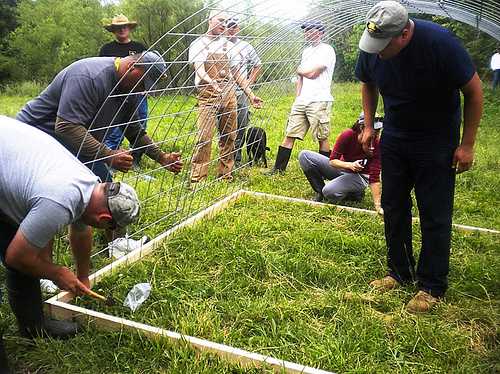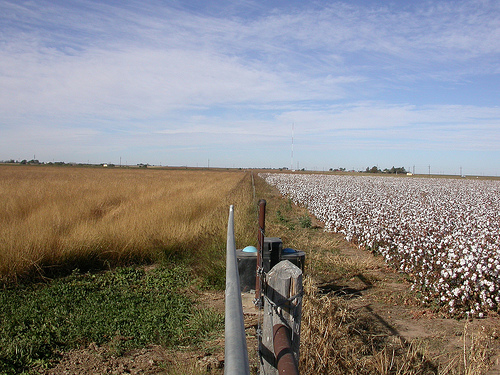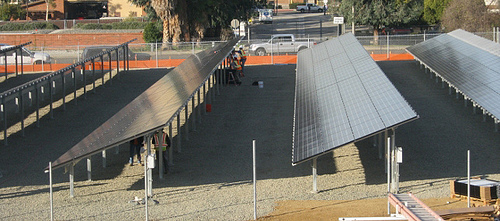
Military veterans-turned-beginning-farmers learn how to build mobile poultry units at an Armed to Farm workshop. Photo credit: University of Arkansas
For many military veterans and their families, the transition from the military to civilian life is a complex undertaking; however, reports and personal accounts indicate that many military veterans have discovered that farming offers a place for employment, training and healing. The problem is there are few educational programs tailored to meet the particular needs and abilities of returning veterans.
The National Institute of Food and Agriculture’s (NIFA) Beginning Farmer and Rancher Development Program (BFRDP) makes it possible to fill that gap in training. At the University of Arkansas, Dr. Dan Donoghue used BFRDP funds to develop internships, workshops and online courses that focus on the needs of veterans interested in pursuing farming after their service to our country. Read more »

Grass and cotton fields in the Texas High Plains study. Credit: Vivien Allen (Texas Tech University).
This post is part of the Science Tuesday feature series on the USDA blog. Check back each week as we showcase stories and news from USDA’s rich science and research profile.
Words like eco-friendly, green, fair, climate-friendly, community-based and organic are popping up daily – in the news, in ads and labels, and in conversations ranging from kitchen tables to international conferences. All of these and more come under the umbrella of sustainability, which people often describe as caring for people, planet and proceeds all at the same time. Read more »

A portion of the 1,288 solar panels on 1.5 acres, which are connected to a 250 kW inverter to produce an estimated 600,000 kW hours of alternating current each year at the Forest Service’s San Dimas Technology Development Center. (Recsolar photo)
About 25 miles east of Los Angeles, the Forest Service’s San Dimas Technology Development Center is ready to start operations using a photovoltaic array to supply the buildings there with a potential 600,000 kilowatt hours of current each year.
“This system has made the San Dimas Center a ‘net-zero energy’ facility, the first in the U.S. Department of Agriculture,” explained Forest Service Chief, Tom Tidwell. “This means the facility produces more renewable energy per year than the total energy used by the facility.” Read more »
More than 800 students, teachers, elected officials and community leaders were present at the new Dillon Middle School dedication on Thursday morning, September 6th. Several years ago, a letter was written to Congress pleading for help to replace the 100 year old dilapidated school by then-eight grader, Ty’Sheoma Bethea.
Doug McKalip, Senior Policy Advisor for Rural Affairs with the White House Domestic Policy Council stated, “I think Ms. Bethea’s letter shows that an individual can have an impact, that the Obama Administration is listening, that we monitor closely the items that folks send by letter, email, and telephone. And that there often is action from the input.”
“This state of the art school is dedicated to the academic advancement of our children. I am pleased that the promise to the children of Dillon County has been kept,” said Vernita Dore, USDA Rural Development state director. Ms. Dore was instrumental in helping to fund construction of Dillon County Middle School, which replaces the old and dilapidated JV Martin Junior High, which was mentioned in President Obama’s first State of the Union address. Read more »
USDA’s Agricultural Outlook Forum provides students with a unique opportunity next February to meet leaders and discuss timely issues at the forefront of America’s agriculture. In 2007, the Agricultural Outlook Forum Student Diversity Program was launched for junior-senior baccalaureate students to attend the event. Former winners say the Forum broadened their horizons as they focused on careers in agriculture. For the first time, graduate students may now also apply.
USDA’s 2013 Agricultural Outlook Forum to be held Feb. 21-22 in Arlington, Virginia, targets students in agricultural disciplines, nutrition and food science or pre-veterinary studies from Land-Grant Colleges and Universities, Hispanic-Serving Institutions, and American Association of State Colleges of Agriculture and Renewable Resources institutions. Read more »
Last week it was my privilege to attend the annual United Tribes Tribal Leaders Summit and associated conferences in Bismarck, North Dakota. This annual gathering is an opportunity for tribal leaders from around the region to exchange information about current issues in Indian Country.
While there, I discussed the importance of the recently-appointed Council for Native American Farming and Ranching. The Council was selected by Agriculture Secretary Tom Vilsack to suggest changes to USDA regulations and to provide internal guidance or propose measures that would promote the participation of American Indian farmers and ranchers in USDA programs and support government-to-government relations between USDA and tribal governments. The Council is a discretionary advisory committee established in furtherance of Keepseagle v. Vilsack, which was a lawsuit alleging past discrimination by USDA against Native American farmers and ranchers in the way it operated its farm loan program.
I also met with Standing Rock Sioux Tribal Chairman Charles Murphy and shared that USDA will fund a water quality project to rehabilitate and expand a failing sewage treatment system serving members of the Standing Rock Sioux Tribe. Read more »



